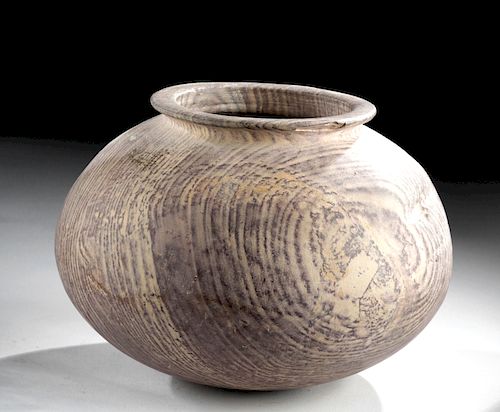Rare Egyptian Predynastic Naqada III Breccia Jar
Lot 11
About Seller
Artemis Fine Arts
686 S Taylor Ave, Ste 106
Louisville, CO 80027
United States
Selling antiquities, ancient and ethnographic art online since 1993, Artemis Gallery specializes in Classical Antiquities (Egyptian, Greek, Roman, Near Eastern), Asian, Pre-Columbian, African / Tribal / Oceanographic art. Our extensive inventory includes pottery, stone, metal, wood, glass and textil...Read more
Categories
Estimate:
$6,000 - $9,000
Absentee vs Live bid
Two ways to bid:
- Leave a max absentee bid and the platform will bid on your behalf up to your maximum bid during the live auction.
- Bid live during the auction and your bids will be submitted real-time to the auctioneer.
Bid Increments
| Price | Bid Increment |
|---|---|
| $0 | $25 |
| $300 | $50 |
| $1,000 | $100 |
| $2,000 | $250 |
| $5,000 | $500 |
| $10,000 | $1,000 |
| $20,000 | $2,500 |
| $50,000 | $5,000 |
| $100,000 | $10,000 |
| $200,000 | $20,000 |
About Auction
By Artemis Fine Arts
Sep 26, 2019
Set Reminder
2019-09-26 10:00:00
2019-09-26 10:00:00
America/New_York
Bidsquare
Bidsquare : Exceptional Day 1: Antiquities & Asian Art
https://www.bidsquare.com/auctions/artemis-gallery/exceptional-day-1-antiquities-asian-art-4437
Day 1 of an important 2-day auction featuring exceptional, museum-worthy examples of Egyptian, Greek, Etruscan, Roman, Viking, Russian, Near Eastern, as well as Asian Art from China, Japan, Thailand, Vietnam, Burma and India. Artemis Fine Arts info@artemisfinearts.com
Day 1 of an important 2-day auction featuring exceptional, museum-worthy examples of Egyptian, Greek, Etruscan, Roman, Viking, Russian, Near Eastern, as well as Asian Art from China, Japan, Thailand, Vietnam, Burma and India. Artemis Fine Arts info@artemisfinearts.com
- Lot Description
Ancient Egypt, Pre-Dynastic Period, Naqada III, ca. 3200 to 3000 BCE. An incredibly rare and finely-preserved example of a utilitarian jar carved from variegated breccia in hues of cream, lavender, and jet-black. The vessel is defined by a round but stable base, a squat spherical body with a sloping shoulder, a deep basin, and a thick discoid rim, and a pair of recessed grooves indicate where the original suspension lugs were situated. The exterior has been polished to be generally smooth in texture, however the interior surface provides for a better understanding of the rough material with which the artisans had to work. Size: 7" W x 4.75" H (17.8 cm x 12.1 cm).
In addition to being quite striking, this jar represents a technological leap forward for the ancient Egyptians. In the early Pre-Dynastic period, artisans hollowed out hard stone vessels using hand-held stone borers and abrasive desert sand. Then, during the Naqada II period (ca. 3600 to 3200 BCE), the invention of copper tubes used to drill very hard stones (in conjunction with sand as an abrasive), allowed people to drill finer forms - like, for example, the grooves indicative of lug handles. However, copper drills only allowed artisans to drill cylindrical items, and so the hollowing out of bulbous vessels like this one still required use of an elongated stone borer in the form of a figure-eight to get under the shoulder. Imagine the hours of work that went into making this single jar!
Provenance: private southern California, USA collection, acquired in the 1970s to mid-1980s
All items legal to buy/sell under U.S. Statute covering cultural patrimony Code 2600, CHAPTER 14, and are guaranteed to be as described or your money back.
A Certificate of Authenticity will accompany all winning bids.
We ship worldwide and handle all shipping in-house for your convenience.
#147321Original lug handles missing, though drilled grooves still remain. Small loss to underside of rim, with minor abrasions and nicks to body, lug handle grooves, and rim. Light earthen deposits as well as smooth surface textures throughout.Condition
- Shipping Info
-
All shipping is handled in-house for your convenience. Your invoice from Artemis Gallery will include shipping calculation instructions. If in doubt, please inquire BEFORE bidding for estimated shipping costs for individual items.
-
- Buyer's Premium



 EUR
EUR CAD
CAD AUD
AUD GBP
GBP MXN
MXN HKD
HKD CNY
CNY MYR
MYR SEK
SEK SGD
SGD CHF
CHF THB
THB
















